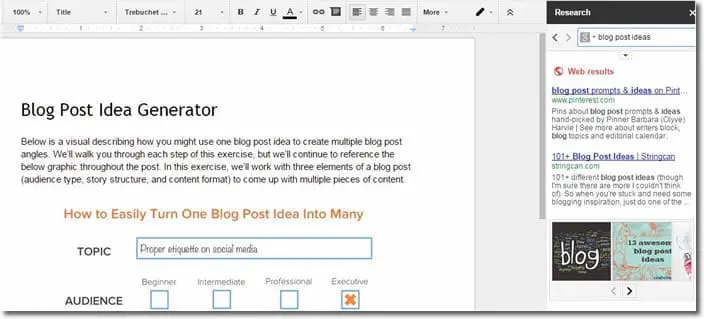 Business blogging is no longer optional for your company. By integrating a business blog into your marketing, you’re giving your company greater online visibility. Basically, you’ll have a larger online presence — from search engines to social media and other sites across the internet.
Business blogging is no longer optional for your company. By integrating a business blog into your marketing, you’re giving your company greater online visibility. Basically, you’ll have a larger online presence — from search engines to social media and other sites across the internet.
HubSpot research reveals businesses that blog generate 55% more website visitors, have 97% more inbound links, and have 434% more indexed pages than companies that don’t blog.
Marketers who have prioritized blogging are 13x more likely to enjoy positive ROI. If you consistently blog, you will reap the benefits. Blogging helps you get found online. Your reach from this alone will bring you leads you wouldn’t have without it — all without the help of advertising and sales people. Day and night, your blog is always working for you.
Whether you’re just getting started with a business blog, or even if you’re a business blogging pro, the goal is for your blog to be an effective marketing tool. We’ve put together the B2B blogging best practices to give you the insights you need to drive qualified traffic to your website, build a strong online presence and generate qualified sales leads.
The 16 B2B blogging best practices
The are the blogging best practices we use on our agency for our own blog (you’re reading it, right?) and for our clients’ blogs.
1) Start with a goal
Before you start your next blog post, think about your goal. This post is likely part of a marketing campaign that you’re running. . . what’s the campaign goal, who is the target audience, what do you want to accomplish with this particular post?
Are you looking to attract more quality visitors to your site? Generate leads? Increase engagement? Become a content leader in your space?
2) Keep your brand in mind
Your blog should act as an extension of your company, so it should encompass all that your brand stands for and values. Losing sight of your brand means losing readers in the process.
Positioning your blog aesthetics and overall voice around your business will also help establish a more personable and relevant experience for your readers. This experience will also humanize your brand, which will make your blog more approachable and readable
3) Know your audience and buyer personas
“Why do I need buyer personas?” The most effective marketers focus their message on the prospect, not on their own product or service. If you don’t know who your target is, and what their problems, frustrations and needs are, how can you expect to even attract them to your website? You’ll be more effective with a highly-targeted strategic approach than by merely creating blog posts by the seat of your pants.
4) Think like a publisher
You’re an online publisher, not a mere blogger! Your job isn’t to put up an article or two each week. Publishers have to create relevant content, determine the best methods to publicize their content to improve reach, and define advertising opportunities as well as manage them. You will do all of these things for your company to ensure that the content you create is valuable to prospective customers and is delivered in a way that can support lead generation for your business.
5) Stay organized
Use a marketing & editorial calendar that’s shared with your entire team to stay organized. Assign different posts to different writers and have a content editor review and approve every post before publishing.

The important thing is to work with your team to develop a process that works well for everyone, and ensures that everyone is on the same page, especially when it comes to your goals.
6) Research first – then write
There is always new content and information to learn; be the ones who deliver that information all in one place. Be the go-to resource for your industry. And present it to your readers in a way that makes them feel like they are coming to your site to get a fun, new, and educational experience that they cannot receive anywhere else!

Cool tool: Use the Research panel in Google Docs for your blog research (Tools > Research). The Research panel allows you to do your research right within the document you’re creating. You can save useful links in your notes simply by clicking the Insert Link button in the search results.
7) Post on a regular schedule – and frequently
In order to receive the best possible results from your business blog, your posts need to be frequent and consistent. How frequent? We recommend at least twice a week for businesses that are using their blog for lead generation.
But it is not just about slapping up a quick post and being done with it. If you want to generate real success then it is important to put time, effort and dedication into each of your posts. Ideally, you want people returning to your blog to read every post. Pay attention to the quality of your content. Is it answering people’s questions? Does it explore industry issues? Address user challenges? If you’re writing for your target audience’s challenges and concerns, and providing new information or insights, you’re right on target!
8) Use different types of content in your blog
Brainstorm different types of content to ignite a spark with your reader. This can range from text-based copy, charts or graphs, infographics, Q&As, videos, interviews, audio content, guest blog posts and/or product reviews.
The most engaging blogs offer content to their readers in many different ways. Plus, if you provide variety in your posts, you will most likely differentiate yourself from the competition – ultimately driving more qualified traffic and generating more leads for your company
9) Write for where your readers are in the buyer’s journey of awareness, consideration, and decision
At the Awareness stage, create awareness of your product, service, or company, so that your buyers begin to understand what you do, and how you can help them. Content should be focused on your buyer’s pain points — not your product or brand.
 As your visitors move into doing more research, educational content like white papers, analyst reports, and industry reports are going to be critical. Build out a few simple lead nurturing campaigns to gradually deliver this content to prospects who have provided their information via a form completion. Remember to lay off the heavy sales pitch; this stage is all about building trust with your prospect and establishing your company as a credible source of information.
As your visitors move into doing more research, educational content like white papers, analyst reports, and industry reports are going to be critical. Build out a few simple lead nurturing campaigns to gradually deliver this content to prospects who have provided their information via a form completion. Remember to lay off the heavy sales pitch; this stage is all about building trust with your prospect and establishing your company as a credible source of information.
At the Consideration stage, buyers have their choices narrowed down to just a few companies and they’ll return to the research stage again. When creating content for this stage, remember to speak the language of the C-suite. Drop the marketing-friendly phrases (like “creative new approach” and “cutting-edge technology”) and focus on the big picture (think “increase revenue” and “return on investment”).
At the Decision stage, buyers have the support of upper management, they’re ready to select a vendor and make a purchase. At this point, they’ll start thinking about preparation, implementation, quick start costs, and customer support — the final items that will determine which solution best fits their needs and budget.
It’s finally time to get brand-specific with your content! When it comes to bragging about your particular product, nothing speaks louder than the experience of your current customers. Have a number of case studies and customer testimonials on hand to show prospects what others have achieved by choosing you, and how positive their experience has been.
10) Be smart about SEO
Optimize for the searcher, not for the search engine. So stop “cheating” the search engine by creating manipulative links. Think like the person you want visiting your website, and optimize for him or her.
Focus on non-branded content. Instead of blogging about your company and products, you should be writing about industry best practices and answering common customer questions about higher level product or service issues. This content will not only help increase search traffic but also drive better quality prospects to your website.
11) Leverage collaborations and guest blogs
If you want visibility, keep a master list of the top bloggers in your industry and reach out to them. Ask them for advice. Ask them for a guest blog. Feature and share their content. You’ll be pulling visits and possibly leads from their audience, and you’ll also be creating valuable relationships with the top experts in your industry. Who knows? They could become evangelists for your product.
12) Promote your content to the places your target audience visits
Use the social media platforms that your buyer persona uses. For B2B companies, that usually means LinkedIn. Make sure your marketing automation system is setup to add every post as a status update on LinkedIn. Post some of your original content on LinkedIn’s publishing platform. Join and participate in groups that your target audience are members of.
If your audience uses other social platforms or forums, be present there, too!
13) Keep your blog part of your website
Chances are, if you are blogging, you will be getting many visitors that have never seen your company before. So it is important that they are able to connect the blog that they have landed on with the company behind it.
Integrating your business blog with your company’s main website not only provides a seamless navigation experience for the reader, but it also helps with your SEO efforts. You instantly have more pages for search engines to index and as you rank higher for certain keywords, you want those visitors to also be able to click around your website once they are done reading a blog post.
It is also important to make sure the navigation and other design elements of your blog make it easy for users to find information about your company if they’re looking for it.
14) Include calls-to-action
Calls-to-action (CTAs) are buttons or images that are placed on a webpage with the intention of driving visitors to a landing page. For best results, include at least one CTA on every blog post (we recommend placing them at the end of your posts), so that the reader has an action to take once they are done reading.
When selecting a CTA for your blog post, make sure it’s relevant to your content. If you have a blog post about creating the highest converting landing page, offer a case study at the end that shows a client taking those steps and increasing their conversions. Unrelated CTAs discourage your leads from clicking, which results in missed opportunities.
15) Conduct a regular content audit
Performing an audit on your existing content will help you determine which topics are important to your audience, what content is reaching the most readers, and what is generating the most results for you. We recommend that you use at least 6 months worth of data so you get a more accurate picture.
How is your content performing? Are your posts gaining shares, comments, etc.? Are you reaching your goals and objectives?
You will discover which areas have taken off, and which might have room for improvement. By doing a content audit, you can also determine if you are covering certain topics too frequently or infrequently and if you aren’t reaching one buyer persona over another.
16) Pay attention to your blog analytics
Keep and eye on your blog analytics (HubSpot > Reports > Page Performance) to see what themes are resonating with your audience. Be sure to look at your older posts, as they likely have gotten a lot of traffic over time. Maybe it makes sense to update and republish an older evergreen post.
And a special BONUS BEST PRACTICE. . .
17) Make sure you have a blog subscription form and that it works!
Have you tested your blog subscription form to see what happens? You may be surprised! This is frequently either not working, or not working properly. Use it to sign up for your blog and then see if you get an email when you expect it and what the email looks like. You can lose an interested visitor really quickly if this process isn’t well thought out and executed.
Now that you have read all about our blogging best practices, how do you plan on implementing them? Are you eager to learn more? Book a call with me for a free blog consultation.
Photo courtesy of Sina at Flickr.




